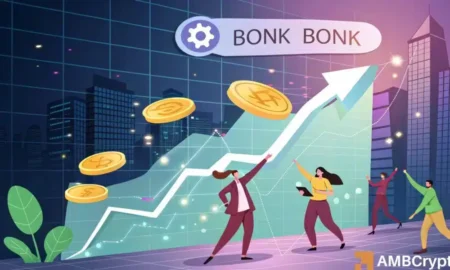Operation Chokepoint 2.0: The Battle for Crypto Legitimacy Under Biden and Trump’s Response
In the ever-evolving landscape of cryptocurrency, "Operation Chokepoint 2.0" has emerged as a critical topic of discussion, particularly under President Biden’s administration. This initiative, characterized by an alleged campaign to discourage banks from servicing crypto firms, has drawn sharp criticism, notably from former President Donald Trump. In light of these developments, the crypto community is increasingly concerned about financial exclusion and the future of digital asset regulation in the U.S. Trump’s recent declarations position him as a pro-crypto advocate, potentially reshaping the conversation around cryptocurrency policy.
Debanking and Its Implications for Crypto
During a recent Oval Office appearance, Trump condemned the ongoing practice of debanking, which he referred to as a “very bad and very dangerous” trend affecting the crypto industry. His remarks underscore concerns that banks, intimidated by regulatory pressure, have begun to sever ties with digital asset firms. This practice, widely seen as an extension of the regulatory overreach associated with Operation Chokepoint 2.0, has resulted in significant challenges for crypto firms attempting to access traditional banking services. Trump’s stance suggests that he believes such actions not only harm the industry but also curtail U.S. competitiveness in the global crypto landscape.
Trump’s insistence that he has personally felt the effects of this debanking reflects a broader narrative among many crypto enthusiasts who argue that existing regulations are stifling innovation. He alluded to a perception that regulators are influencing bank behavior, creating a culture of fear that inhibits financial institutions from engaging with crypto ventures. By framing the issue as a question of liberty and innovation, Trump appears to rally support from those who view cryptocurrency as an integral part of the future economy.
The Need for Executive Action
While Trump did not commit to signing an executive order to address the debanking situation, he did emphasize the urgency of the matter, implying that it still requires decisive action. His reluctance to outline a specific strategy has raised questions about his intentions and possible conflicts of interest, particularly regarding his family’s involvement in crypto-related ventures. Despite this, Trump emphasized the strategic importance of the U.S. embracing crypto. He warned that if the country were to turn its back on digital currencies, opportunistic nations like China could quickly capitalize on the void, furthering their technological advancements and economic influence.
In redefining the narrative around cryptocurrency, Trump’s approach poses a stark contrast to Biden’s regulatory stance. The former president strongly suggests that the federal government should actively create a conducive environment for the crypto industry, thus aligning with the interests of innovation, economic growth, and national competitiveness. His statements reflect an understanding that the U.S. must adapt to the rapid technological changes presented by digital assets.
Contrasting Approaches: Trump vs. Biden
Understanding the divergent approaches of the Biden and Trump administrations is essential for comprehending the current landscape of crypto regulation. Under Biden, there has been an ongoing narrative that insinuates regulators have pressured banks to cut ties with digital asset firms, a move critics labeled "Operation Chokepoint 2.0." This explicit push led to considerable financial exclusion in the crypto sector, increasing barriers for firms that require banking services. With this in mind, Trump’s administration, had it retained power, would likely have not only dismantled such regulatory barriers but also sought to actively promote pro-crypto legislation.
Currently, the gap between the two administrations’ views on cryptocurrency is stark. Trump has indicated that his administration would focus on rolling back restrictions that hinder crypto operations, such as policies like SAB 121, which critics claim impede access to vital banking services. This contrasts sharply with Biden’s perceived regulatory caution that many believe stifles growth and innovation.
The Federal Reserve and Future Directions
Adding another layer of complexity to this debate is Trump’s ongoing criticism of Federal Reserve Chair Jerome Powell, whom he initially appointed. Trump recent comments refer to Powell as a “stubborn mule” and expressed a desire for him to resign. This critique underscores a growing frustration within the pro-crypto community regarding the Fed’s approach to interest rates and, more broadly, monetary policy. Transitioning towards a more friendly environment for crypto involves addressing concerns about banking services, and Trump’s pressure on Powell could influence future Fed policies that affect crypto firms.
Simultaneously, Powell has suggested that while banks can engage with crypto, they must implement strong risk controls owing to the industry’s novelty. This cautious approach has gained traction amid increasing calls for clarity and support for the crypto sector. Recent reports imply that a forthcoming executive order may prohibit banks from denying services to crypto firms solely based on their industry affiliations or political views. Such movement could signal a significant shift in how financial institutions engage with the rapidly evolving crypto space.
The Way Forward for Cryptocurrency in the U.S.
The current landscape surrounding Operation Chokepoint 2.0 poses challenges and opportunities for the future of cryptocurrency in the U.S. The contrasting perspectives of Trump and Biden highlight the broader societal and economic debates surrounding digital assets. Trump’s proactive embrace of cryptocurrency advocates for a shift in regulatory approaches that prioritize innovation over caution, suggesting an array of legislative measures that aim to bolster the U.S. position within the global crypto economy.
This developing narrative points to the potential for a more supportive federal policy environment should pro-crypto sentiments gain traction. As regulatory frameworks evolve, the crypto community eagerly anticipates whether upcoming executive actions or legislative efforts will provide the necessary safeguards and encouragement for the industry to thrive.
In conclusion, the ongoing discourse surrounding Operation Chokepoint 2.0 encapsulates a pivotal moment for cryptocurrency regulation in the U.S. The dichotomy between the Biden and Trump administrations reflects broader societal values regarding innovation, risk, and economic progress. As both sides continue to navigate this complex landscape, the path forward for cryptocurrency remains uncertain yet filled with potential for growth amidst evolving regulatory discourse.

















